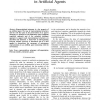Free Online Productivity Tools
i2Speak
i2Symbol
i2OCR
iTex2Img
iWeb2Print
iWeb2Shot
i2Type
iPdf2Split
iPdf2Merge
i2Bopomofo
i2Arabic
i2Style
i2Image
i2PDF
iLatex2Rtf
Sci2ools
JCP
2006
2006
The Emergence of Autonomous Representations in Artificial Agents
Representational autonomy is a key property of an artificial agent. The type of representational structures and the role they play in the preservation of an agent's autonomy are pointed out. The limitations of the traditional cognitivist approach and of the embodied intelligent approach to support such representational structures are described and indicated. A framework of self-organising Peircean semiotic processes is introduced and it is then applied to demonstrate the emergence of autonomous representations in an artificial agent interacting with the environment.
| Added | 13 Dec 2010 |
| Updated | 13 Dec 2010 |
| Type | Journal |
| Year | 2006 |
| Where | JCP |
| Authors | Argyris Arnellos, Spyros Vosinakis, Thomas Spyrou, John Darzentas |
Comments (0)

